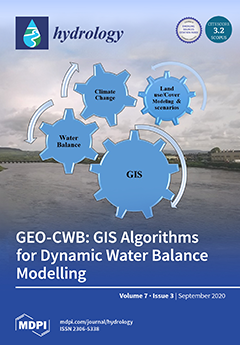A classic method for assessing the reference crop evapotranspiration (ET
o) is the pan evaporation (E
pan) method that uses E
pan measurements and pan coefficient (k
p) models, which can be functions of relative humidity (RH), wind speed (u
[...] Read more.
A classic method for assessing the reference crop evapotranspiration (ET
o) is the pan evaporation (E
pan) method that uses E
pan measurements and pan coefficient (k
p) models, which can be functions of relative humidity (RH), wind speed (u
2), and temperature (T). The aim of this study is to present a methodology for evaluating the robustness of regression coefficients associated to climate parameters (RH, u
2, and T) in pan method models during recalibration at local conditions. Two years of daily data from April to October (warm season) of meteorological parameters, E
pan measurements from class A pan evaporimeter and ET
o estimated by ASCE-standardized method for the climatic conditions of Thessaloniki (Greece, semi-arid environment), were used. The regression coefficients of six general nonlinear (NLR) regression E
pan models were analyzed through recalibration using a technique called “random cross-validation nonlinear regression RCV-NLR” that produced 1000 random splits of the initial dataset into calibration and validation sets using a constant proportion (70% and 30%, respectively). The variance of the regression coefficients was analyzed based on the 95% interval of the highest posterior density distribution. NLR models that included coefficients with a 95% HPD interval that fluctuates in both positive and negative values were considered nonrobust. The machine-learning technique of random forests (RF) was also used to build a RF model that includes E
pan, u
2, RH, and T parameters. This model was used as a benchmark for evaluating the predictive accuracy of NLR models but, also, for assessing the relative importance of the predictor climate variables if they were all included in one NLR model. The findings of this study indicated that locally calibrated NLR functions that use only the E
pan parameter presented better results, while the inclusion of additional climate parameters was redundant and led to underfitting.
Full article





